1995 CADILLAC ELDORADO engine overheat
[x] Cancel search: engine overheatPage 12 of 395
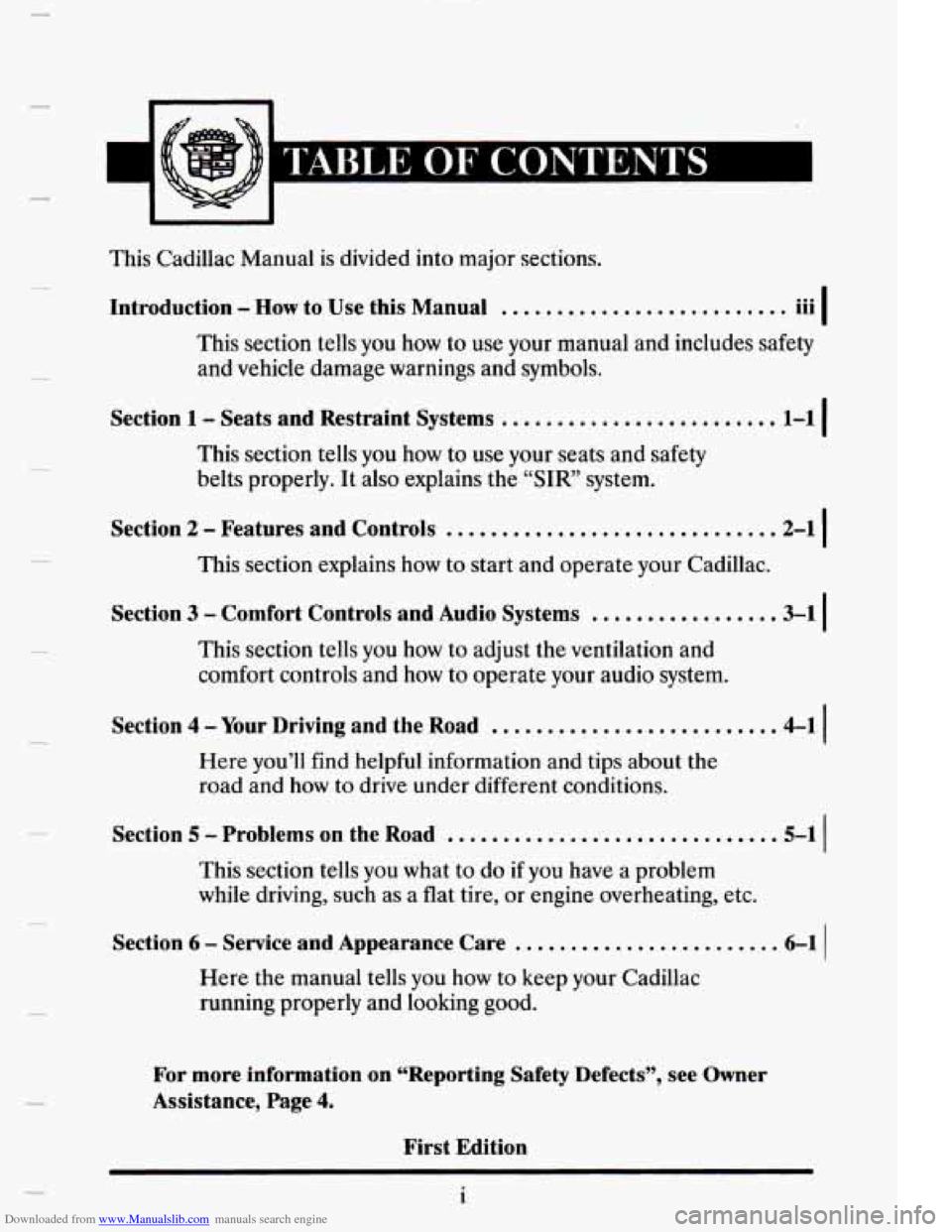
Downloaded from www.Manualslib.com manuals search engine .., ,-. I..C .,
This Cadillac Manual is divided into major sections.
Introduction - How to Use this Manual .......................... iii I
This section tells you how to use your manual and includes safety
and vehicle damage warnings and symbols.
Section 1 - Seats and Restraint Systems ......................... 1-1 I
This section tells you how to use your seats and safety
belts properly. It also explains the
“SIR’ system.
Section 2 - Features and Controls ............................. .2-1 I
This section explains how to start and operate your Cadillac.
Section 3 - Comfort Controls and Audio Systems ................. 3-1 I
This section tells you how to adjust the ventilation and
comfort controls and
how to operate your audio system.
Section 4 - Your Driving and the Road ......................... .4-1 I
Here you’ll find helpful information and tips about the
road and
how to drive under different conditions.
Section 5 - Problems on the Road ............................. .5-1 I
This section tells you what to do if you have a problem
while driving, such as a flat tire,
or engine overheating, etc.
Section 6 - Service and Appearance Care ....................... .6-1 I
Here the manual tells you how to keep your Cadillac
running properly and looking good.
For more information on “Reporting Safety Defects”, see Owner
Assistance, Page
4.
First Edition
i
Page 24 of 395
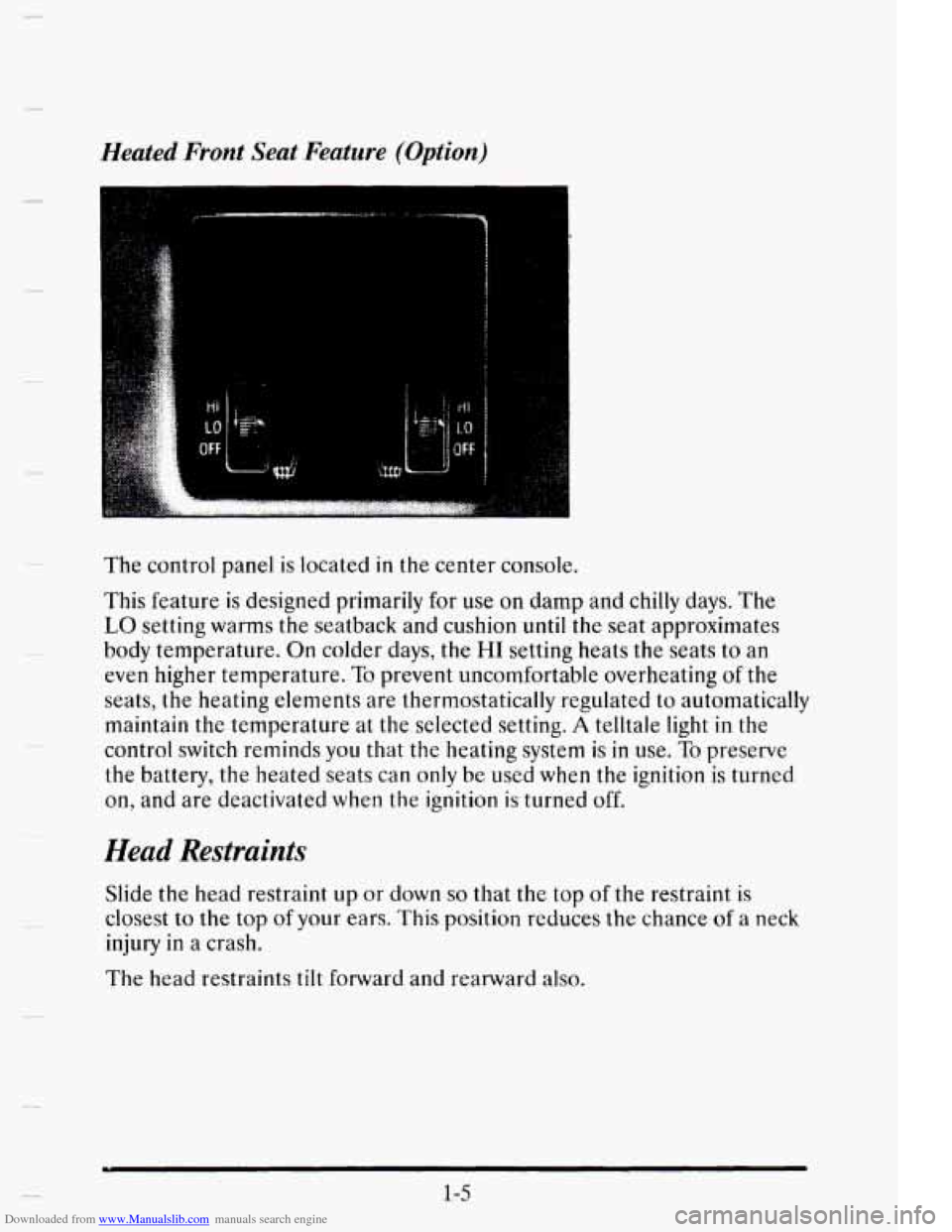
Downloaded from www.Manualslib.com manuals search engine Heated Front Seat Feature (Option)
c
The control panel is located in the center console.
This feature
is designed primarily for use on damp and chilly days. The
LO setting warms the seatback and cushion until the seat approximates
body temperature.
On colder days, the HI setting heats the seats to an
even higher temperature.
To prevent uncomfortable overheating of the
seats, the heating elements are thermostatically regulated to automatically
maintain the temperature at
the selected setting. A telltale light in the
control switch reminds you that the heating system is in use. To preserve
the battery, the heated seats can only be used
when the ignition is turned
on, and are deactivated when the ignition is turned off.
Head Restraints
Slide the head restraint up or down so that the top of the restraint is
closest to the top of your ears. This position reduces the chance of a neck
injury
in a crash.
The head restraints tilt forward and rearward
also.
1-5
Page 97 of 395
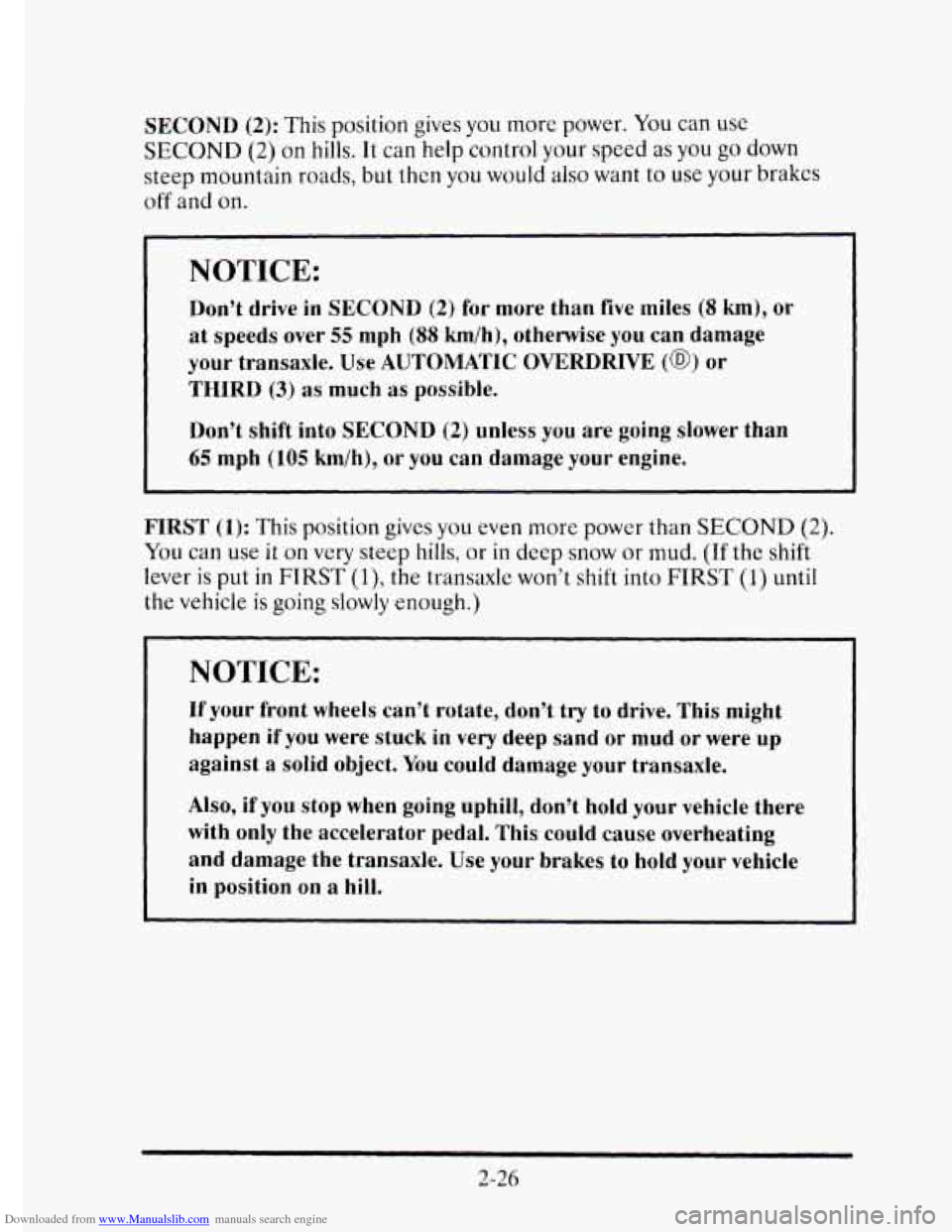
Downloaded from www.Manualslib.com manuals search engine SECOND (2): This position gives you more power. You can use
SECOND (2) on hills. It can help control your speed as you go down
steep mountain roads, but then you would also want to use your brakes
off and on.
NOTICE:
Don’t drive in SECOND (2) for more than five miles (8 km), or
at speeds over 55 mph (88 km/h), otherwise you can damage
your transaxle.
Use AUTOMATIC OVERDRIVE (@) or
THIRD (3) as much as possible.
Don’t shift into
SECOND (2) unless you are going siower man
65 mph (105 km/h), or you can damage your engine.
FIRST
(1): This position gives you even more power than SECOND (2).
You can use it on very steep hills, or in deep snow or mud. (If the shift
lever is put
in FIRST (I), the transaxle won’t shift into FIRST (1) until
the vehicle is going slowly enough.)
NOTICE:
If your front wheels can’t rotate, don’t try to drive. This might
happen
if you were stuck in very deep sand or mud or were up
against a solid object. You could damage your transaxle.
Also,
if you stop when going uphill, don’t hold your vehicle there
with only the accelerator pedal. This could cause overheating
and damage the transaxle. Use your brakes to
hold your vehicle
in position on a
hill.
2-26
Page 99 of 395
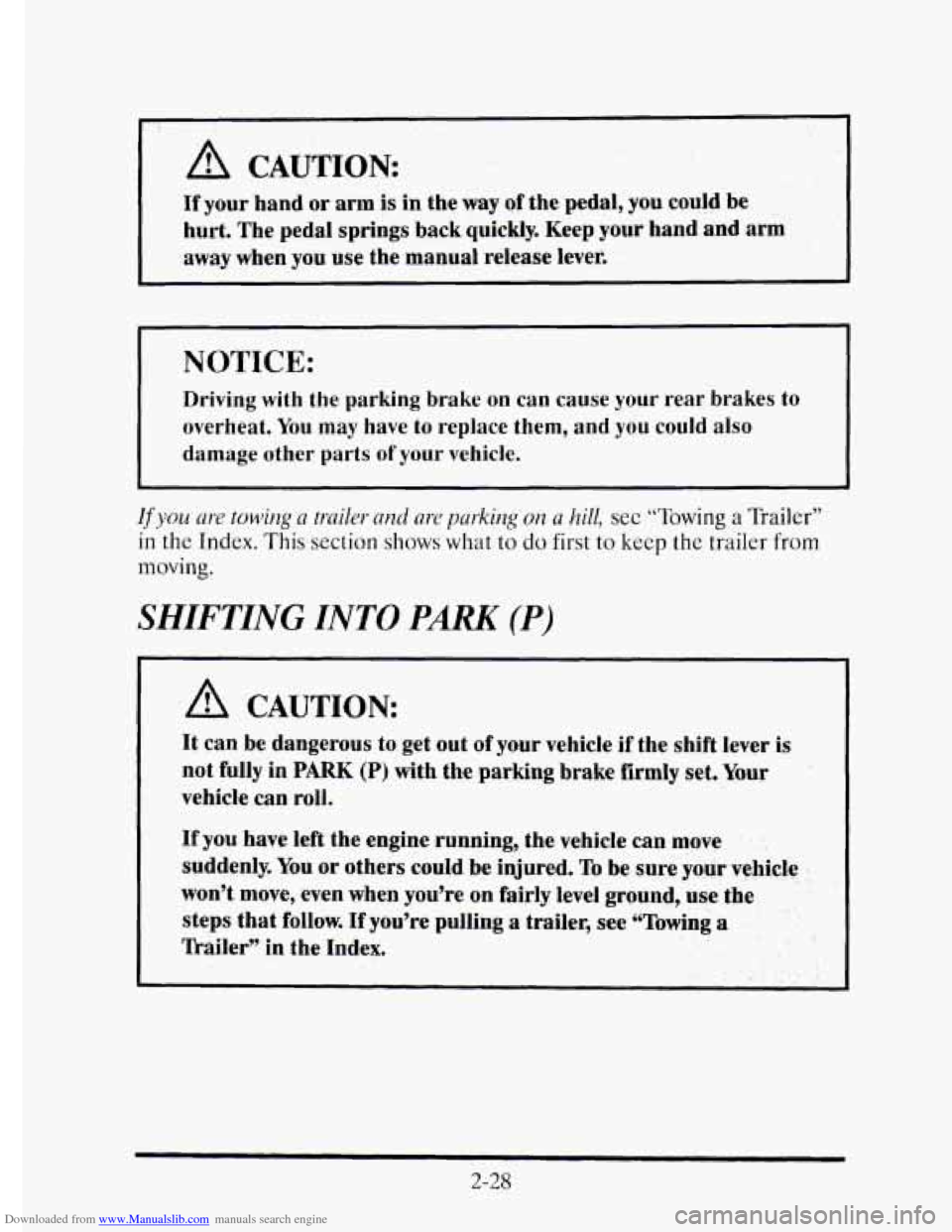
Downloaded from www.Manualslib.com manuals search engine A, CAUTION:
If your hand or arm is in the way of the pedal, you could be
hurt.
The pedal springs back quickly. Keep your hand and arm
away when
you use the manual release lever.
I NOTICE:
Driving with the parking brake on can cause your rear brakes to
overheat. You may have to replace them, and you could also
damage other parts
of your vehicle.
If you are towirg u truiler and are parking on a hill, see “Towing a Trailer”
in the Index. This section slmws what to do first to kecp the trailer from
moving.
SHIFTING INTO PARK (P)
A CAUTION:
It can be dangerous to get out of your vehicle if the shift lever is
not fully in PARK (P) with the parking brake firmly set. Your
vehicle can roll.
If you have left the engine running, the vehicle can move ’’
suddenly. You or others could be injured. To be sure your vehicle
won’t
move, even when you’re on fairly level ground, use the
steps that follow.
If you’re pulling a trailer, see “Towing a
ll-ailer” in the Index.
.. ...
2-28
Page 139 of 395

Downloaded from www.Manualslib.com manuals search engine Rear Ashtray
To open the rear
ashtray
lift the lid.
~
NOTICE:
Don’t put papers or other flammable items into your ashtrays.
Hot cigarettes
or other smoking materials could ignite them,
causing
a damaging fire.
Cigarette Lighter
It’s located near the ashtray. To use the lighter just press it all the way and
let go. When it’s ready, it will pop back by itself.
NOTICE:
Don’t hold a cigarette lighter in with your hand while it is
heating. If you do, it won’t be able to back away from the
heating element when it’s ready. That can make it overheat,
damaging the lighter and the heating element.
2-68
Page 149 of 395
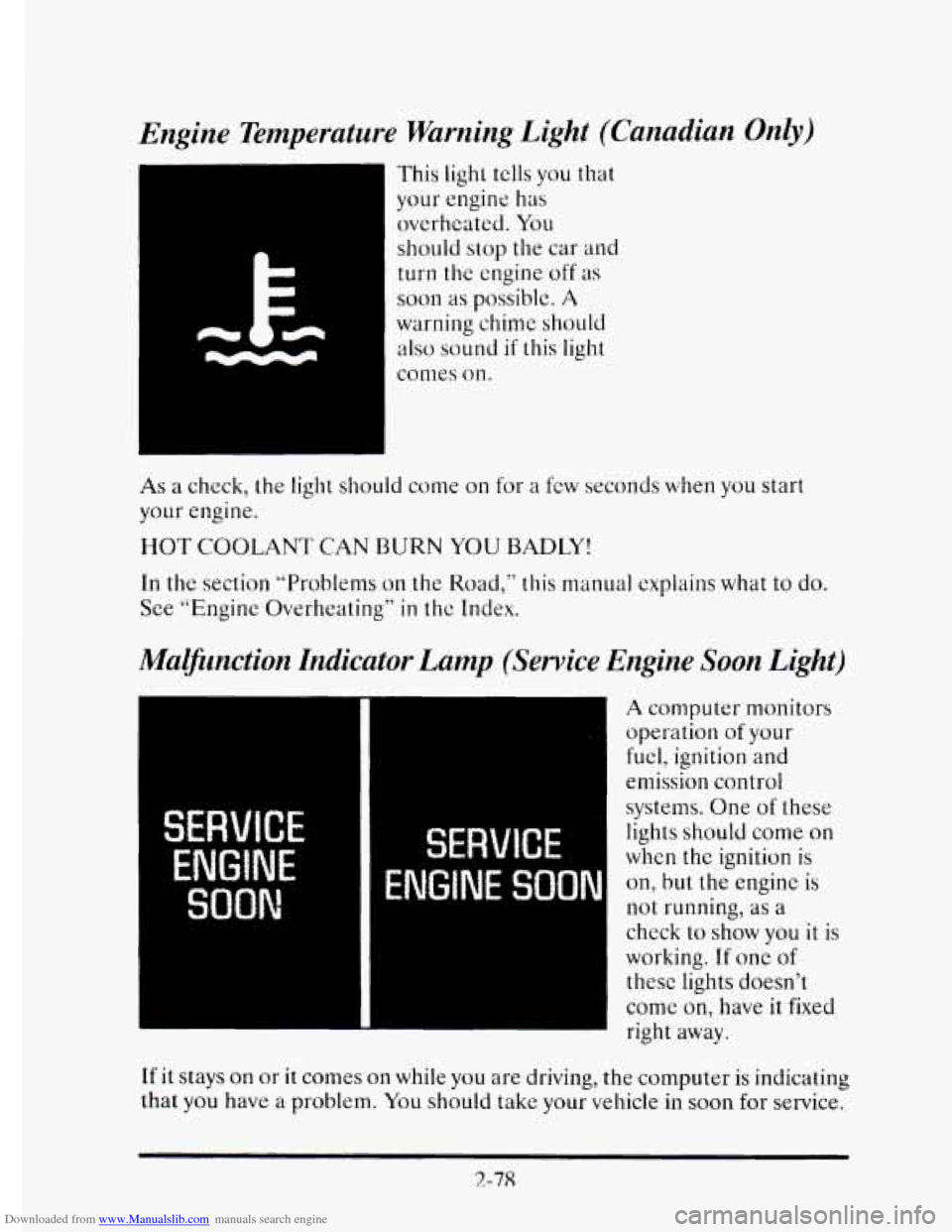
Downloaded from www.Manualslib.com manuals search engine Engine Temperature Warning Light (Canadian Only)
This light tclls you that
your engine has
overheated. You
should stop the car
and
turn the engine off as
soon as possible. A
warning chime should
also sound if this light
comes on.
As a check, the light should come on for a few seconds when you start
your engine.
HOT COOLANT CAN BURN YOU BADLl’!
In the section “Problems on the Road,” this manual explains what to do.
See “Engine Overheating”
in thc Index.
Mammction Indicator Lamp (Service Engine Soon Light)
I
w
A computer monitors
operation
of your
fuel, ignition and
emission control
systems. One
of these
lights should come
on
when the ignition is
on, but the engine is
not running, as a
check to show you it is
working.
If one of
these lights doesn’t
come
on, have it fixed
right away.
If it stays on or it comes on while you are driving, the computer is indicating
that you have a problem. You should take your vehicle in
soon for service.
2-78
Page 157 of 395

Downloaded from www.Manualslib.com manuals search engine Driver Information Center Messages
These messages will appear if there is a problem sensed in one of your
vehicle’s systems. Vehicles
that are first sold in Canada will have a number
after each message.
This number hclps to identify the message which is
only displayed in English.
APPLY BRAKE TO SHIFT - 46
This message will appear if your vehicle is in PARK (P) for about
15 seconds and
the brake is not pressed in. If you do not want this
message
to appear, you can cancel it by holding the OFF and the blue
(cooler) button on
the Electronic Climate Control panel for about five
seconds. Hold the same
two buttons again to have this message displayed
again.
A/C OVERHEATED - A/C COMPRESSOR OFF - 15
If the refrigerant system ever rcaches an over-pressure condition, this
message
will appear to tell you that the air conditioning compressor has
been turned off. Air conditioned air
will not be delivered to cool your
vehicle.
If the pressure returns to a normal operating range, you must
select AUTO,
DEFOG or DEFROST to start the compressor. If this
message continues to appear, have the system repaired
as soon as possible
to avoid compressor damage.
BATTERY NO CHARGE - 07
This message will appear if your battery is not being charged. Have your
electrical system checked
by your Cadillac dealership at your earliest
convenience.
BATTERY VOLTS HIGH - OS
This message shows that the electrical charging system is overcharging
(more than
16 volts). To avoid being stranded have the electrical system
checked by your Cadillac dealership.
You can reduce the charging
overload by using the accessories.
Turn on the lamps and radio, set the
climate control
on AUTO and the fan speed on HI, and turn the rear
window defogger on.
You can monitor battery voltage on the Driver
information Center by toggling the INFORMATION button. The normal
range is 1 1.5
to 15.5 volts when the engine is running.
2-86
Page 159 of 395
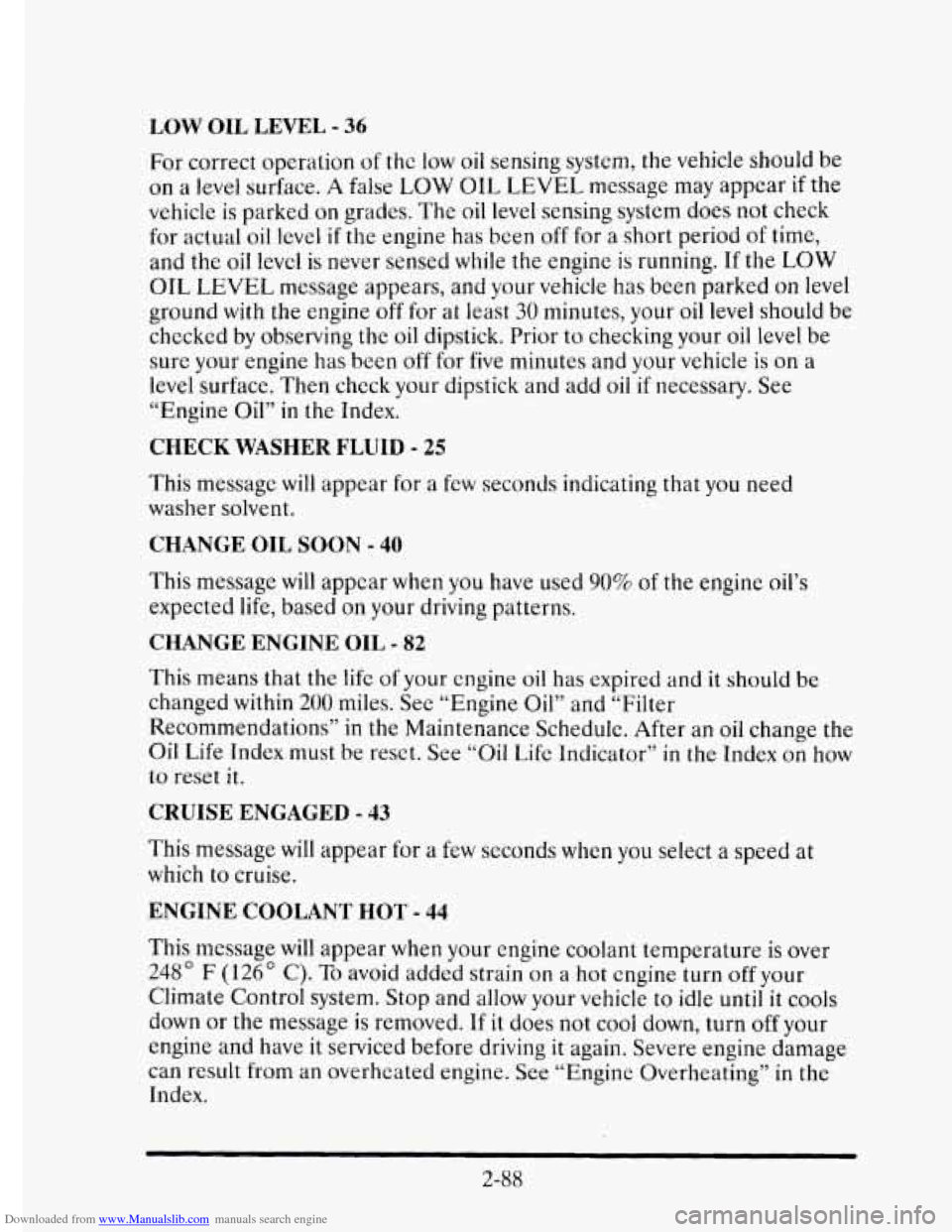
Downloaded from www.Manualslib.com manuals search engine LOW OIL LEVEL - 36
For correct operation of the low oil sensing system, the vehicle should be
on a level surface. A false LOW OIL LEVEL message may appear if the
vehicle is parked
on grades. The oil level sensing system does not check
for actual oil
level if the engine has been off for a short period of time,
and the
oil level is never sensed while the engine is running. If the LOW
OIL LEVEL message appears, and your vehicle has been parked on level
ground with
the engine off for at least 30 minutes, your oil level should be
checked by observing the oil dipstick. Prior to checking your oil level be
sure your engine has
been off for five minutes and your vehicle is on a
level surface. Then check your dipstick and add oil if necessary. See
“Engine
Oil” in the Index.
CHECK WASHER FLUID - 25
This message will appear for a few seconds indicating that you need
washer solvent.
CHANGE OIL SOON - 40
This message will appear when you have used 90% of the engine oil’s
expected life, based on your driving patterns.
CHANGE ENGINE OIL - 82
This means that the life of your engine oil has expired and it should be
changed within 200 miles. See “Engine Oil” and “Filter
Recommendations”
in the Maintenance Schedule. After an oil change the
Oil Life Index must be resct. See “Oil Life Indicator” in the Index on how
to reset it.
CRUISE ENGAGED - 43
This message will appear for a few seconds when you select a speed at
which to cruise.
ENGINE COOLANT HOT - 44
This message will appear when your engine coolant temperature is over
248’ F (126’ C). To avoid added strain on a hot cngine turn off your
Climate Control system. Stop and allow your vehicle
to idle until it cools
down or the message is removed.
If it does not cool down, turn off your
engine and have it serviced before driving
it again. Severe engine damage
can result from an overheated engine. See “Engine Overheating” in the
Index.
2-88